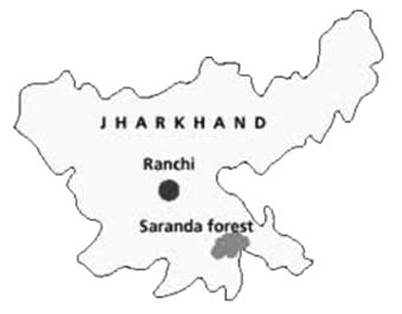Why in news?
- The Supreme Court has directed the Jharkhand government to declare 31,468.25 hectares (314 sq. km.) of the Saranda forest as a wildlife sanctuary.
- This ends the State’s reluctance and its earlier proposal to declare only 24,941.64 hectares due to concerns over mining and infrastructure.
- The court emphasised the State’s constitutional duty to protect ecologically significant areas and balance conservation with sustainable mining.
Relevance
- GS 3 – Environment & Biodiversity
Sal forest ecosystem; wildlife sanctuary declaration; threatened species - GS 3 – Conservation vs Development
Mining–ecology conflict; sustainable mining; iron ore reserves - GS 2 – Judiciary / Constitutional Provisions
Public trust doctrine; State’s duty to protect forests

Basics: where and what is Saranda?
- Location: West Singhbhum district, Jharkhand.
- Known as one of the world’s most pristine sal forests.
- Ecological features:
- Dominant sal (Shorea robusta) ecosystem.
- Home to endemic sal forest tortoise, four-horned antelope, Asian palm civet, wild elephants.
- Social context:
- Inhabited for centuries by Ho, Munda, Uraon and allied Adivasi communities.
- Livelihoods deeply tied to minor forest produce and cultural traditions.
Why is the area contentious?
- Saranda forest division also contains 26% of India’s iron ore reserves.
- SAIL and Tata Steel depend critically on mining in this region.
- Judicial declaration of the entire 314 sq. km. as a sanctuary could:
- Restrict or reshape mining operations.
- Affect employment in mining-linked areas.
- Require reevaluation of several leases.
Key observations of the Supreme Court
- State’s duty:
- Forests and wildlife must receive statutory protection where ecologically significant.
- The State cannot “run away from its duty to declare” such areas.
- Balanced approach:
- Conservation must coexist with sustainable iron ore mining, not eliminate it.
- Sanctuary notification does not automatically extinguish tribal rights.
- Community protection:
- Court directed mass communication that individual and community forest rights under FRA, 2006 will not be adversely affected.
- Ecological significance:
- Court stressed the unique sal ecosystem, biodiversity richness, and presence of threatened species.
Government’s position (as per hearings)
- Initially proposed declaring only 24,941.64 hectares due to:
- “Vital public infrastructure” in the remaining area.
- Concerns about halting mining.
- Later clarified:
- The 31,468.25 hectares being considered had no mining, no non-forest use, and no prior diversion.
- After the court’s push, the government agreed to proceed with full notification.
Ecological significance
- Saranda is a high-integrity sal landscape—rare globally.
- Functions as a critical elephant habitat and corridor.
- Sanctuary status ensures:
- Stricter protection under the Wildlife (Protection) Act, 1972.
- Better control over fragmentation from roads, mining, and encroachments.
Mining–conservation tension
- Region’s mineral value is extremely high (26% national iron ore).
- Conservation imperatives clash with:
- Employment generation.
- Steel sector supply chains.
- Local economic activity.
- Court’s directive pushes for “sustainable mining + strict ecological zoning” rather than blanket bans.
Tribal rights and welfare
- FRA, 2006: Sanctuary notification cannot extinguish existing rights.
- Court acknowledged:
- Tribes are ecosystem stakeholders.
- Sanctuary declaration must not lead to displacement.
- Important shift from earlier models of exclusionary conservation.
Governance implications
- Sets a precedent:
- States must declare ecologically important areas even if economically sensitive.
- Strengthens judicial oversight over forest governance.
- Enhances application of:
- Precautionary principle
- Public trust doctrine
- Requires integrated landscape planning for:
- Mining zones
- No-go biodiversity zones
- Community rights areas



